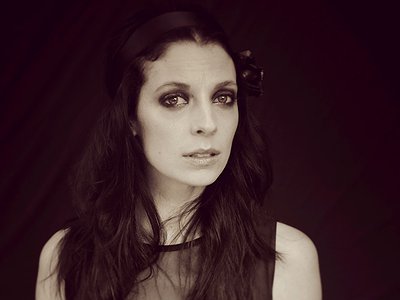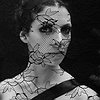Name: Emily Mirla Harrison
Occupation: Composer, Pianist, Screen composer, Nurse
Nationality: Australian
Current release: Solitaire (The Virtue of Patience)
Recommendations: Phosphorescence by Julia Baird A book on awe, wonder and things that sustain you when the world goes dark. I highly recommend this book for any woman
it’s poetic, inspiring, wise and illuminating /Lisa Sorgini’s photo series ‘Behind Glass’. Images of women and children in quarantine. It’s raw and powerful - words can’t explain it, you just need to take a look for yourself.
If you enjoyed this interview with Emily, visit her website www.mirla.com.au
When did you start writing/producing music - and what or who were your early passions and influences? What was it about music and/or sound that drew you to it?
I’m from a modestly musical family. A distant relative once sailed from Australia for London to pursue a career as an opera singer - it didn’t work out. My great grandmother was an uncelebrated concert pianist. My father, a school Headmaster, produced, directed and scored the school’s musicals. At night, he’d strum his acoustic guitar, tapping a foot to Simon and Garfunkel and Cat Stevens or play Mozart and Bach on the piano.
From the age of 7 I learnt piano upon the knee of both my grandmothers. I went on to study classical piano. For our family, having a piano was more essential than TV. My early musical passion was to combine piano with moving images. I’ve recollections of being 9 or 10, playing piano and composing to TV images – the sound turned down. I don’t know what drew me to it. For me music is as sustaining as water and food. It creates a space and time to self-soothe, reflect and travel inward. Music illuminates me, from the inside.
For most artists, originality is preceded by a phase of learning and, often, emulating others. What was this like for you: How would you describe your own development as an artist and the transition towards your own voice?
As a teenager, I loved Rachmaninoff's complex and romantic music - it’s all I would play. The slamming notes and beautiful chords, gut wrenching motifs, the tricky ostinatos. In terms of film composition I loved Alan Silvestri’s ‘Forest Gump’ and James Horner’s ‘Legends of the Fall’. After 15 years, I’m stunned to hear the influence of Horner in my album ‘Solitaire (The Virtue of Patience)’. It isn’t intended: it’s simply there.
My signature sound retains a Romantic influence, with the added lyricism of folk and pop music, shaped by a passion for cinematic music and its techniques, honed through my screen composing work. In my 20’s I publicly performed folk covers on piano or guitar. In time, I journeyed from emulating others, to interpreting songs, to developing a more artistic approach, composing original music and creating an aesthetic that was authentic to how I felt, what I observed or was moved by.
I recorded original music as alt pop artist ‘Lincoln’, releasing ‘Visions of a Fading Light’: an EP of dark, piano driven vignettes about love, loss and life. I was inspired by intelligent, ‘outsider’ solo female artists like Jewel, Tori Amos and Regina Spektor.
In my film work I’ve developed a distinctive creative voice, which emerged from the crucible of the aforementioned influences and training. With my Mirla solo project, I consider myself a Neo-classical or modern classical artist, blending classical elements with contemporary technology and compositional techniques. I’ve been swimming around this fascinating pool for the last few years, discovering the work of Australians like Luke Howard, Nat Bartsch, Sophie Hutchings and leading European exponents like Olafur Arnalds. It’s in this realm that my artistic development has reached a new level. Mirla and my album Solitaire is an expression and culmination of three varied decades of musical learning.
How do you feel your sense of identity influences your creativity?
Over time we cease pretending to be what we are not: our identity takes on a more definite shape. For me, music is a mother, teacher and doctor – and is inseparable from my sense of self. My creative tendencies explore introversion and melancholy. I especially lock into creativity when its nocturnal, quiet and I’m sad. Where does it come from? I’m not sure. I experienced loss early in life when aged 7 my mum died from a brain tumour. That event must have been catalyst for shaping my character and sense of identity – and subsequently my creativity.
The album ‘Solitaire’ was born from a need to connect to my Grandmother’s history, which, of course, connects me to my mother. Perhaps it’s part of processing my grief and letting go. It’s also about celebrating my family's identity, by telling the story of how my Nana waited for my Pop, after he was lost at sea, captured as a Japanese Prisoner of War. It’s family legend: a remarkable, classic Australian story.
As a nurse, I get to experience all the intensity and beauty of human experience as I observe my patients and their families go through sickness, death and birth. It’s a privilege to witness moments where all social camouflage is stripped away. I think I process these human stories and use their inspiration to create.
What were your main creative challenges in the beginning and how have they changed over time?
Time is the enemy of my creativity, and stress my enemy’s evil brother. The need to earn enough money to live necessarily limits the amount (and quality) of creativity that can be harnessed into my practice and production. Even when there’s spare time to create it’s a challenge to put myself into a mindset of being ideally relaxed, rested, yet stimulated and inspired to create: it’s a tricky balancing act. This is especially so for women with young children. Women remain underrepresented in filmmaking and female film composers represent only 13% of the Australian industry. Opportunities are limited. The industry is responding to redress the balance by organising and networking to raise the profile and capacity of women in music and film. Perhaps COVID has taught the industry to support more flexible work arrangements, which would, in turn, support women to juggle their creative lives with other income sources and a family life.
Confidence is also limiting. For me the creative process can be very psychological, therefore vulnerable to being derailed when confidence evaporates like a waterhole in the desert. Trusting in your innate abilities and vision are pathways back to creativity. I’ve also learnt that creativity need not always be stimulated by challenging situations. I’ve come to understand that with regular practice and application creativity is a deep well: I need only lower a bucket to draw-up the creative waters.
As creative goals and technical abilities change, so does the need for different tools of expression, be it instruments, software tools or recording equipment. Can you describe this path for you, starting from your first studio/first instrument? What motivated some of the choices you made in terms of instruments/tools/equipment over the years?
Although piano is my dominant instrument to play and compose on my creative practice has evolved to incorporate more musical tools, often necessitated by the requirements of project briefs and creative direction.
Composing in a DAW (Logic Pro) has empowered me to expand into an inexhaustible library of instrumentation, enabling me to play with a wider palette of sounds. It has opened up a sonic world! With my film work I’ll search for interesting samples, use electronic orchestral instruments, design weird atmospheres and soundscapes: anything to create textures, mood and bring emphasis to key dramatic cues.
For my album Solitaire, I really have combined all that I’ve learnt. There are several piano solo pieces, which represent my signature sound for emotive, lyrical melodies, with intricate and meditative note repetitions. I’ve used a spoken word device to help tell the remarkable story of my grandmother’s psychological state as she waits over two years for the safe return of her sweetheart sailor boy. I’ve recorded my own voice as an ambient instrument and to narrate excepts from my grandparents’ wartime letters, diaries and original poetry written by my husband. I’ve included the haunting recordings of my grandparents’ voices.
I love Una Corda sample library: It provides many creative choices in its sound banks of attack, fabric preparations, mechanical elements, pedals, hiss, compression and vintage tones. I also compose the accompanying string parts for cello, violin and viola, some of which were performed on incredible vintage instruments.
I have incorporated various subtle electronic elements, soundscapes and field recordings of sounds in nature, to create more sonic layers and textures and to help immerse the listener in authentic sounds of the album’s geography and creative universe. It’s a genuinely cross-genre album.
Have there been technologies or instruments which have profoundly changed or even questioned the way you make music?
I’m constantly questioning the way I make music. With technology and connectivity being what it is, one can only self-limit.
The practical and financial barriers of orchestra use has somewhat been crossed by the quality of electronic reproduction. Why go to the trouble and cost of arranging music for performance by an orchestra? Well, as musicians we accept that those instruments resonate more powerfully and the performance dynamic is irreplaceable. That said, the power of a Nils Frahm solo performance makes me question even that wisdom. I’ve had some vocal training and record my vocals and the vocals of others. In my projects I’ve applied warped vocal effects to find interesting sounds or to represent a feminine or masculine element, whether they be characters or gendered associations. I want to explore this more in my next work. I’m questioning how far I can go with it and how it might inform my next work. I want to learn how to loop live vocals and incorporate it into performance alongside experimenting with ‘prepared piano’.
[Read our Nils Frahm interview]
Collaborations can take on many forms. What role do they play in your approach and what are your preferred ways of engaging with other creatives through, for example, file sharing, jamming or just talking about ideas?
I enjoy the process of collaboration. This is a surprise to me! In my earlier career, I tended to work alone, reaching only inwards for inspiration. Film composing has taught me just how productive and interesting it is to collaborate.
A film director or production team may have a clear musical vision. More often the engagement begins with the sharing of project images, footage or storyboard. Scoping discussions, with lots of back-and-forth, help me frame a musical direction to best support the Director’s vision. There will be obvious dramatic cues or visual motifs and themes that can be supported by musical forms. Sometimes, it’s about explaining where the absence of sound will best serve the story.
When recording Solitaire, I found so much joy in studio recording and working closely with my studio engineer. The studio’s ambience and smell, the intimacy, the infinite potential for magic and sonic variation that can be achieved through banks of technology and by collaborating with someone who’s entirely focused on the audio and atmospheric qualities. In the creative process, there is potential for blockages, self-doubt or technical knowledge gaps, the studio collaboration bridges or diminishes these traps, setting you on a new path or clearing the path you’re already on.



